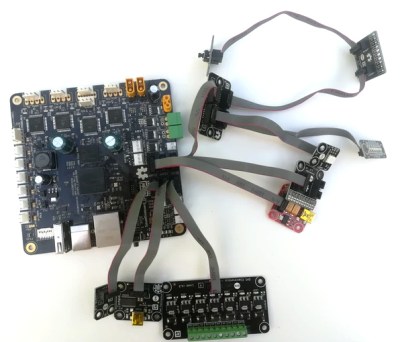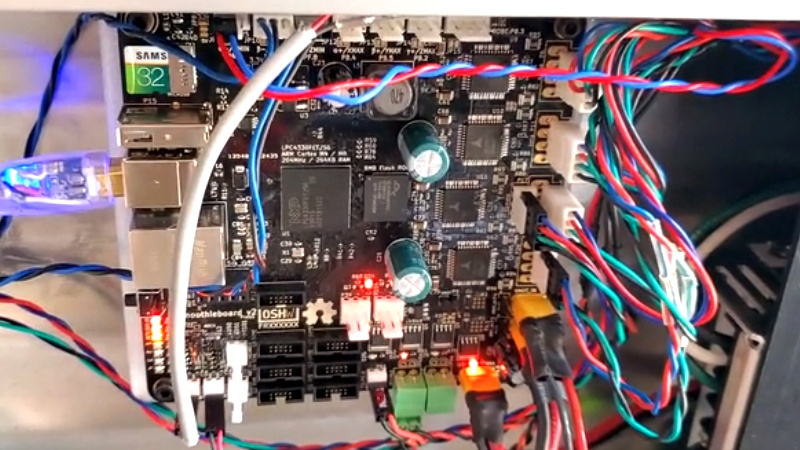If you’ve been reading Hackaday for awhile, there’s an excellent chance you’ve seen a project or two powered by the Smoothieboard. The open source controller took Kickstarter by storm in 2013, promising to be the last word in CNC thanks to its powerful 32-bit ARM processor. Since then we’ve seen it put to use in not only the obvious applications like 3D printers and laser cutters, but also for robotic arms and pick-and-place machines. If it moves, there’s a good chance you can control it with the Smoothieboard.
But after six years on the market, the team behind this motion control powerhouse has decided it’s time to freshen things up. The Kickstarter for the Smoothieboard v2 has recently gone live and, perhaps unsurprisingly, already blown past its funding goal. Rather than simply delivering an upgraded Smoothieboard, the team has also put together a couple “spin-offs” targeting different use cases. If Smoothie v1 was King of CNC boards, then v2 is aiming to be the Royal Family.

The direct successor to the original board is called v2-Prime, and it’s everything you’d expect in an update like this. Faster processor, more RAM, more flash, and improved stepper drivers. There’s also available GPIO expansion ports to connect various breakout boards, and even a header for you to plug in a Raspberry Pi. If you’re looking to upgrade your existing Smoothieboard machines to the latest and greatest, the Prime is probably what you’re after.
Then there’s the v2-Mini, designed to be as inexpensive as possible while still delivering on the Smoothieboard experience. The Mini has the same basic hardware specs as the Prime, but uses lower-end stepper drivers and deletes some of the protection features found on the more expensive model. For a basic 3D printer or laser cutter, the Mini and its projected $80 price point will be a very compelling option.
In the other extreme we have the v2-Pro, which is intended to be an experimenter’s dream come true. It features more stepper drivers, expansion ports, and even an integrated FPGA. Realistically, this board probably won’t be nearly as popular as the other two versions, but the fact that they’ve even produced it shows how committed the team is to pushing the envelope of open source motion control.
Our coverage of the original Smoothieboard campaign back in 2013 saw some very strong community response, with comments ranging from excited to dismissive. Six years later, we think the team behind the Smoothieboard has earned a position of respect among hackers, and we’re very excited to see where this next generation of hardware leads.
















Nice!
Signed up for the Kickstarter. Keep on the good work and stick to the shipping date. ;)
Thanks a lot :) There are more risks we’ll be a bit late this time than with the v1 kickstarter ( it’s a more complex project ), but we are going to do our very best.
Encoders?
We actually plan on playing with encoder readings and servo-like features on the v2-pro using the FPGA. That won’t come right away though, first we have to do the work to get the FPGA to generate steps.
If encoders are on the table, I’m in. I need to be able to run dc motors with encoders
It won’t come right away, I want to be clear on that, but it’s planned for v2-pro. Note nowadays there are servo ( DC+encoder ) drivers available at nearly the same price as stepper drivers, and that look exactly the same ( step/direction interface ) to a Smoothieboard, so support of the servos on-board by the Smoothieboard isn’t really critical, and we are likely going to try it mostly just to have closer control of what’s going on ( for example to easier report errors/problems ).
When the replacement controller board costs more than the actual 3d printer ;-)
In general, and especially in 3D printing, you usually get what you pay for and you absolutely never get what you don’t pay for.
$100-200 printers are exactly what you’d expect them to be if you’re a rational person.
This is sort of why we have made the v2-mini, we have good hopes we can bring it’s public price down to $70 with time.
Still expensive as hell, can make a board that is smoothieware/marlin compatible, with integrated driver trinamic with less than $50-60
Well, you’d probably be able to make that board at that price, but shipping, QC, testing, hard and soft dev, documentation, community work, user support, are all things the chinese clones ( mostly ) don’t do, and we have to do. We are *not* getting rich off of this, in 7 years of doing Smoothie, I’ve mostly gotten into debt ( and live under the poverty line ), and that’s despite having a business on the side selling Smoothie-powered laser cutters, that is profitable, and the benefits of which are mostly fed back into Smoothie dev ( just sales at the prices you complain of wouldn’t even be enough to continue ).
You know, I hear that complaint often, and it seems like the people who say that haven’t really thought very far about what’s involved in doing all this. Thankfully there are plenty of people who do understand, and give us very positive feedback on what we do, and that feedback is a big part of what keeps me going despite so few benefits and so much hard work …
If u try klipper u never come back
But why spartan6? they are outdated and use ISE10 which is notoriously difficult to run on win10 (unless you have win10 entreprise with VM support)?
Lattice iCE40 and iCE40 ultraplus are supported by opensource tools!
And I personally prefer i.MX RT instead of lpc43xx as lpc43xx is not supported by mcuxpresso tools/SDK.
You are wrong on two counts:
>ISE Design Suite for Windows 10 – 14.7
>Last Updated February 2018
>This version of ISE Design Suite only supports Spartan®-6 FPGAs.
You don’t need win 10 enterprise to run a VM either.
>You do realize you CAN run virtual machines on any version of Windows right? They can run VirtualBox or VMWare and run a VM of anything they want to without Microsoft Hyper-V or the Pro or Enterprise version of the OS.
If you don’t like a particular choice of FPGA, microcontroller on an *open source* project, you can folk it you know. That’s the whole point of having source code.
FYI: This is the instruction for the regular webpack ISE 14.7 to run on win10 x64. It basically involves copying a couple of files, renaming them for the 32-bit “PlanAhead” program to run under x64. There is also a replacement batch file on the forum.
https://www.eevblog.com/forum/microcontrollers/guide-getting-xilinx-ise-to-work-with-windows-8-64-bit/
>10/8/15: This guide will also work for Windows 10 64-bit
I have installed ISE14.7 on a clean Win10 pro 1903 install just a couple of days ago.
Also the Spartan as FPGA is BG, expensive and not really in the openspurce spirit. I agree that the ice40’s would have been a better choice here, if they meet the requirements.
Also dealing with ise, ugh. Try integrating that into your CI and VCS. You can setup project the right way, but requires some messing about with tcl.
We have close ties to the Papillio project, using similar hardware is going to speed things up a lot for us. Once we have everything working, we might actually choose the next FPGA we used based on Open-Sourceness and performance.
The next being v3 or the next itteraton?
Probably v2.1, when we add the CAN bus and a few other things. At the very least a year away.
what would you gain out of using this over something like an skr 1.3 or 1.1 pro which both cost less and allow you to use whatever drivers you want?
Better MCU, more extensions, runs the Smoothie v2 firmware, better PCB and connectors.
Not to mention it supports the project which many others (including SKR) use and benefit from.
I am trying to determine why they need a FPGA and TMC5160 devices? And why a A7+M4 CPU, it is not like they need a dual core with either the FPGA or TMC5160 – I would think a cheaper higher speed single core M3 would work with the TMC products. I’m seeing TMC5161 driver boards for ~ $12